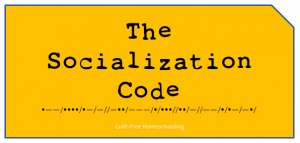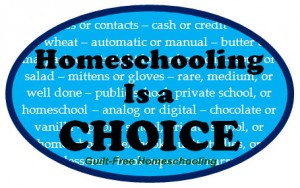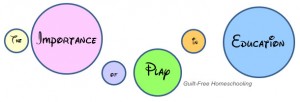Over the years, I have fielded many questions on socialization from people who do not understand the choice to homeschool. The Questioners have ranged from total strangers to close friends to family members, but their questions have all fallen into a few distinct, but implied, meanings. Each time, the basic question of “What about socialization?” — no matter how it had been worded — seemed to have an underlying, coded meaning.
Coded Meaning #1 — “How will your child learn to deal with bullies?” A homeschooled child learns to see bullying for exactly what it is: unacceptable behavior. Homeschooled students do not grow up in the constant shadow of bullies, and do not become accustomed to kowtowing to them. Homeschoolers who have never been forced to surrender their lunch money or their seat on the school bus or their place in line recognize that no one else has a right to take these things away from them. When confronted with one, they instinctively stand up to the bully, call his bluff, and end the cycle right there. My homeschool students had grown up talking comfortably with adults, so they were also not shy about speaking to the adults in authority to report bullying and other unacceptable behaviors.
How to reply to this question:
“If you are asking if I am trying to isolate my child from bullies, I am actually teaching him how to stand up to them, instead of just sacrificing him to them. Believe it or not, being bullied is not an essential part of life. As for a model for dealing with it, the patriots in the Revolutionary War stood up to some serious bullying, but then, they were homeschooled, too. ” (And don’t back down from the bully who is asking this question.)
Coded Meaning #2 — “How will your child learn to operate under proper social order?” This Questioner is probably also a bully, and his question “What about Socialization?” is really asking if your child will “learn to stay in his place” in the social order of this bully’s worldview. However, homeschooled students will learn that they each have unique, individual talents and abilities, and therefore they also learn to accept other people for their varied abilities and contributions to life. Public schools tend to categorize everyone by an impenetrable “caste system” of Jocks, Nerds, Geeks, Rich Kids, Cool Kids, Slow Learners, etc. Public school graduates continue to categorize people into these groups for the rest of their lives. Once a Jock, always a Jock; once a Geek, always a Geek– just ask Bill Gates.
How to reply to this question:
“Our everyday experiences of schoolwork, shopping, and church functions put us in contact with a wide variety of people. Through those experiences, I am teaching my students that I value them for their individual achievements, and they are learning to value others for their individual achievements. The important thing to recognize in life is that everyone excels at something. ”
Coded Meaning #3 — “Will your child be able to go to Prom?” Yet another coded question, which can have two more possible, coded meanings: A) “Won’t your children be heartbroken at missing the biggest social event of their lives?” or B) “Are you telling me that it is possible to avoid the inevitable sacrifice of my children to drunkenness, promiscuity, and excessive spending without turning them into social outcasts and misfits?”
For “Meaning A,” a young homeschooling mom asked my daughter if she had regretted not having a Prom, and my daughter explained how her group of homeschooling friends had organized a nice dinner at the home of one of the families. The group invited all of the high school students, and they wore modest, dressy (but not formal) attire. Boutonnieres and wrist corsages were provided by the parents, the house was appropriately decorated for the festivities, and the three-course meal was prepared and served to the teens by several of the mothers. After the banquet-style meal was over, the teens retired to the family room for ping-pong and table games. Regarding the specific event of a “Prom,” my daughter replied that she would have loved to have had the fancy dress, but did not mind skipping the heartache that is usually attached to frivolous relationships. (This questioning mom sighed and asked if my daughter was available for adoption.)
As for Prom being the “biggest social event” of one’s life, I disagree. While it may be construed as The Most Important Event during high school, that ranking is bestowed by shallow, selfish, immature people who have little idea what Life actually entails. The brief period that was my high school social life has ranked fairly low in importance when compared with the rest of my life.
For “Meaning B,” there are parents who view Prom as a rite of passage, no matter how decadent it has become, and encourage their teens to take part. Many teens also believe that they are entitled to participate in the ritual, often demanding that it include limousines, hotel rooms, and alcoholic beverages, despite the legal-age barrier. (If you still think of Prom as an innocent part of the high school experience, ask the local obstetrics unit how busy they become nine months after each Prom.) Many of the parents who do recognize the debauchery frequently associated with today’s Proms are ultimately afraid of a negative reaction from their teenage children, fearing rebellion and rejection by their children if they, as parents, refuse to allow their teens to attend. However, this Questioner probably spent less for her first car than prom dates can cost today, so she may really be interested in finding an escape from the frivolous financial excess.
How to reply to this question:
This Questioner (most often female) may have no clue to the actual non-importance of Prom in the scope of Real Life. If you attempt to tell her that Prom is no big deal, she will only hear that you are dooming your child to life as a hermit. Therefore, if your students are much too young to be concerned about Prom yet, tell the Questioner that you “will deal with that when the time comes.” If that still does not pacify the Questioner, try telling her that your students “could always be invited to Prom by public school friends.” (Receiving an invitation doesn’t mean they have to go.) Assure this Questioner that there are many wonderful, acceptable alternatives to Prom being hosted by homeschool groups today that provide wholesome, safe activities for the students who choose to participate.
Coded Meaning #4 — “Will your child get to experience ‘all the fun I had’ in high school?” This question is usually from a grandmother or older friend or relative who has no idea what public high schools have become. This Questioner remembers one important dance for all of high school: one sweetly romantic event for which she made herself a special dress and carried a nosegay of flowers from her date’s mother’s garden — an evening which climaxed in a few moments of good-night hand-holding on her front porch swing at 10pm (while her father supervised from behind the window curtains). Most kids did not own cars in high school or in college either, when the Questioner was busy having all that fun. No one could spend hour after hour watching cable television stations devoted solely to the pornography of vulgar music videos, and a Saturday night “date” meant seeing a (G-rated) movie with a group of friends, walking en masse to the ice cream parlor for a sundae, then scattering back home before 10:00 pm so they could all get up for church the next morning.
How to reply to this question:
When this Questioner asks you about socialization, she merely wants to know that your child will not be locked away and forced to do endless lessons without ever glimpsing the light of day. Assure the Questioner that your homeschool “will include plenty of interaction with other students” — that is all she really wants to know.
There are many other superfluous questions that frequently accompany the “What about socialization?” question. We have been asked questions like these in rapid-fire succession without giving us time to form an answer, but then again, many of them did not deserve answers. “How will your children learn to stand in line?” “How will your children learn to raise their hands to ask a question?” “Are you Amish?” “Isn’t it child abuse to keep your children away from other people?” “Will your children even talk? How will they learn to talk with other people when they grow up?” And my all-time, personal favorite: “How will your daughter ever find anyone to date?”
If and when you are faced with questions regarding the socialization of your homeschooled students, take a few seconds to evaluate the person who is asking the question. You may even want to ask him to clarify it and explain exactly what he is concerned about. If the person is truly worried about the well-being of your students, assure them that you are taking all the necessary precautions to provide your students with a well-rounded education, including social interaction with acceptable peers. If, however, the Questioner seems to be rudely accusing that all homeschoolers should be held in suspicion, try answering his question with one of your own: “I notice you don’t go to school either. What do you do for socialization?”
[For more on this topic, see the articles linked below.]
Socialization and Why You Don’t Need It (The Socialization Myth, Part 1)
The Socialization Myth, Part 2
The Myth of Age-Mates





 Guilt-Free Homeschooling is the creation of Carolyn Morrison and her daughter, Jennifer Leonhard. After serious disappointments with public school, Carolyn spent the next 11 years homeschooling her two children, from elementary to high school graduation and college admission. Refusing to force new homeschooling families to re-invent the wheel, Carolyn and Jennifer now share their encouragement, support, tips, and tricks, filling their blog with "all the answers we were looking for as a new-to-homeschooling family" and making this website a valuable resource for parents, not just a daily journal. Guilt-Free Homeschooling -- Equipping Parents for Homeschooling Success!
Guilt-Free Homeschooling is the creation of Carolyn Morrison and her daughter, Jennifer Leonhard. After serious disappointments with public school, Carolyn spent the next 11 years homeschooling her two children, from elementary to high school graduation and college admission. Refusing to force new homeschooling families to re-invent the wheel, Carolyn and Jennifer now share their encouragement, support, tips, and tricks, filling their blog with "all the answers we were looking for as a new-to-homeschooling family" and making this website a valuable resource for parents, not just a daily journal. Guilt-Free Homeschooling -- Equipping Parents for Homeschooling Success!

Recent Comments